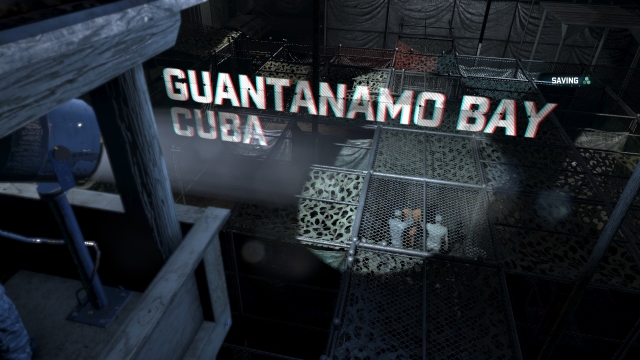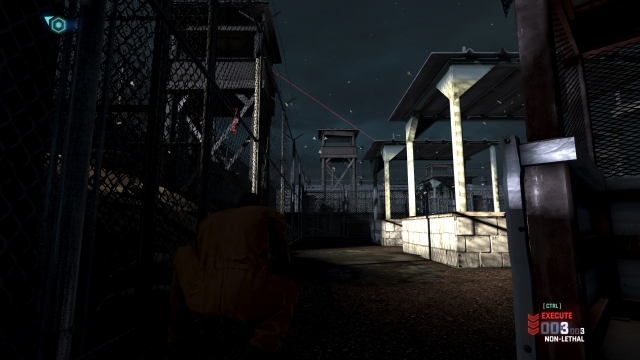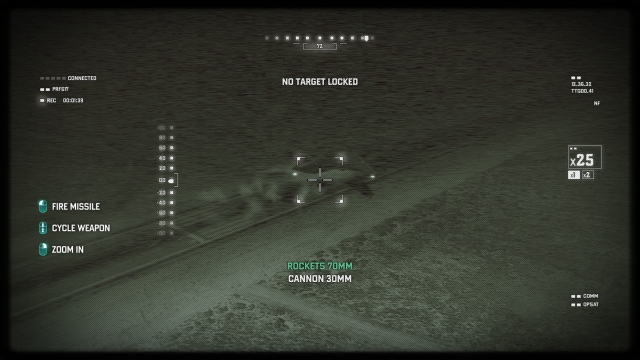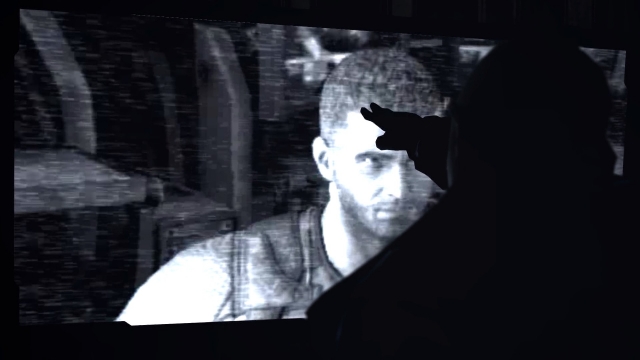
Splinter Cell Blacklist Diaries Part Six
This is my ongoing exploration of the Tom Clancy’s Splinter Cell games, played in release order. I will chronicle my playthrough of each title in turn and discuss any recurring themes and noteworthy events. This time I continue Blacklist.
Because Fourth Echelon had stopped the American Freedom attack, the Engineers had moved the American Fuel attack up to three days instead of a week…
We received intel that Reza Nouri had been pulled in to Guantanamo Bay, the US facility which houses terrorists of all shades. Unfortunately, the CIA was stonewalling Fourth Echelon due to them pretty much going behind their backs so often over the last few weeks.

Sam was NOT entertained by this news
The plan, of course, was to infiltrate Gitmo and find out what Nouri knew about American Fuel. So, as you do, Sam had himself arrested (on purpose this time) and put into the Bay. Briggs, due to still having friendly CIA contacts, was able to get access to the site, where he perp-walked Sam down to interrogation.

As opposed to Guantanamo Bay, Idaho
Once there, he left me with the handcuffs, and the knowledge of where my equipment was, and went to secure a boat of some description. After a brief bit of torture, Nouri revealed that Sadiq, leader of the Engineers, had told Nouri to hand himself in, and set up a war with Iran. He then requested a quick death, to avoid a slow one as punishment, so I snapped his neck.
The power went out thanks to Grim, and I left the cell. Out of the building, I watched a guard enter the next building, and went around to the open window to gain access. I slowly made my way to the exit, stopping only to knock out a few guards like a ninja master. Outside, I avoided two snipers, and climbed up to a pipe and around to a ledge where I found a dead drop. I dropped down onto an armoured man, before realising I’d made a mistake and climbed back up, slamming a guard’s face into the ledge before leaving the yard.

It's not like I wanted to stay in that yard, anyway
Carefully entering the next yard, it was full of people. I ducked behind some concrete blockades, and went along the line of them, being very surprised when the lights suddenly came back on just before I reached the end. I very carefully ducked behind a truck and went around it. Someone spotted me, but I knocked him out before he alerted anyone - then leapt up in through an open window on the building there. Another guard greeted me and I had to quickly belt him before he alerted anyone too, before dashing into the locker room.
Briggs had stashed my equipment, so I was finally fully equipped, and now had a crossbow.
The next section, however, did not go as smoothly as the last. I was spotted and quickly shot a few people - unfortunately, the fourth man had a shield. I threw a smoke grenade before running around him and the others flanking my former position. I entered a warehouse and turned off the light, shooting the three men inside before leaving through the open doors.
Knocking out the first man I came across, I used my sonar goggles to avoid a dog, and knocked out a second man who did not seem like a guard. I went through a basketball court, avoiding the temptation to try and play a little, before exiting through the gate which wasn’t a gate. It’s weird, because the “door” part wasn’t the bit that was open, instead it was around the side, making it more useless than the gate I once saw that had a wall built behind it.
I mean, look at this! Why?
Climbing up to a guard tower, I knocked out a sniper before sending my drone over to the opposite side so I could shoot the other sniper with a sticky shocker. That done, I shot a couple of other men before getting back to the ground and avoiding a dog. I hid beneath another sniper tower and drone-shot him, before shooting the dog which had caught my scent. I put the drone away before climbing over the fence and heading for Briggs.

Did I say beach? I meant "cliffside"...
Just a short walk and climb down the beach, and I was with Briggs. I reported my findings whilst we waited for Grim’s signal to leave, and exfiltrated. I had no idea what Brigg’s story would be for not leaving via official channels, but nevermind that.
Back at the Paladin, we suddenly came under fire - the Engineers had located us. The drone was being rendered useless by a scrambler, so we had to hold them off while Grim prepared the plane for takeoff. Briggs claimed he was providing covering fire, while I decided to give it the head-on approach. I ran for cover and took out a couple of them at close range with a taser, before realising I had the wrong weapon selected.
I bagged and tagged a high priority target before getting spotted, though it didn’t slow me as I used it to my advantage and threw grenades. The next wave was blasted and shot, as was the following one before I ran out of grenades. I switched to tear gas and managed to avoid getting shot more than a few times, before the plane was ready. I ran up the gantry, and Briggs took control of the drone - a few rockets and dozens of rounds of ammo later, and we were in the air.

To be frank, I considered firing at the Paladin to see what happened...
Unfortunately, when Charlie began unpacking a large amount of Engineer server data, it gave them a backdoor to the plane’s systems. Unknown to the team, Sadiq ordered American Fuel to go ahead, and for his man to take down the Paladin…

"I am jealous of how much hair he has."
Accessing the SMI (the main Paladin computer) seemed to activate whatever the Engineers had planted, and the whole system began going screwy. Suddenly, the engines died off, and the plane juddered, knocking out the pilot. The co-pilot took over, claiming that, with help, he could maybe glide for minutes “manually”. I was pretty sure that, due to there being no positive thrust, there was literally no lift beneath the wings to facilitate gliding, but I’m not an aerospace engineer.

Yeah, well, that's like, your opinion, man!
Briggs went to help the co-pilot, and I went to let Kobin out of his cell to help out. As soon as I had done that, Sam told Briggs to get to the cargo bay. I was pretty sure there was more than one other person on this plane who could have done that instead of the guy helping pilot the jet, but hey I’m also not a military leader.
Kobin had said that we needed to reboot the plane and jettison some cargo. When I got to the cargo bay, Briggs had already opened the doors, and we pushed the helicopter out. Unfortunately, it got jammed, and I had to climb along the ceiling to shoot the door struts out, which was definitely not going to aid our aerodynamics.

That's a steep dive...
The helicopter fell out, and Kobin told me to get beneath the SMI to turn off the main power breaker. I did so, and then had to get to the cockpit whilst the plane was in a steep dive. I eventually reached it, and Kobin rebooted the system somehow with the main power breaker still off, but you guessed it I’m not an electrical engineer.
Charlie restored the SMI to a backup, but the last communique we had received said that the higher members of government had been hidden away in bunkers. With communication out, we could only assume that American Fuel had been successful…











COMMENTS